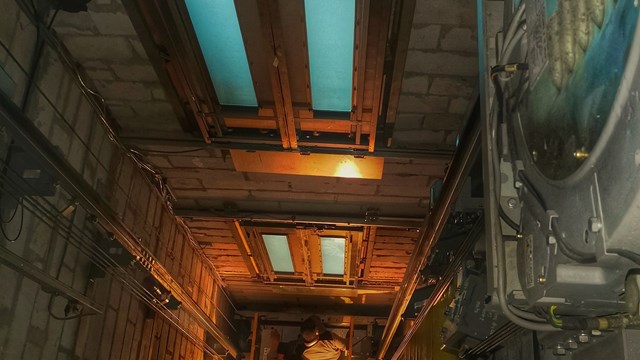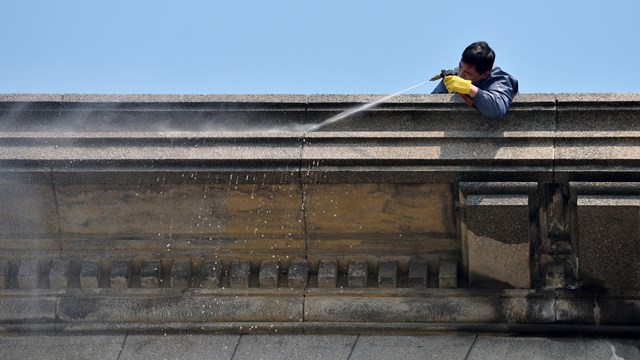It’s the end of another long day at work. You come home, lock the door, flop down on the couch and take a deep breath. Time to rest easy. But consider that deep breath. How clean is the air in your co-op or condo? Do you really want to know?
In recent years, co-op and condo residents and boards have been spending more money than ever surveying air quality and cleaning up aging air filtration systems. With asthma and other respiratory problems on the rise, building owners and occupants are taking a second look at air quality–and doing something about what they find.
Indoor Air Hazards
Newspapers and newscasts are filled each day with stories of outdoor air pollution–the hazy clouds hanging over Los Angeles, the ominous odors permeating America’s industrial areas. Research shows that the stuff outside can often be child’s play compared to what’s behind our own curtains.
According to the Environmental Protection Agency (EPA), Indoor Air Quality studies of human exposure to air pollutants "indicate that indoor air levels of many pollutants may be two to five times, and occasionally, more than 100 times higher than outdoor levels." Startling numbers, given the EPA’s estimate that most people spend as much as 90 percent of their time indoors.
Poor indoor air quality can be responsible for everything from eye irritation to throat dryness and itchy skin to chronic sinusitus and asthma–a recently-diagnosed condition known as "Sick Building Syndrome."
The causes of Sick Building Syndrome are almost as myriad as the condition’s symptoms. The likeliest suspects, according to the EPA, are inadequate ventilation, indoor chemical contaminants like adhesives, pesticides, soot from fireplaces, and the fuel emissions from space heaters and gas stoves, along with outdoor chemical contaminants from nearby garages, commercial kitchens, or motorways. Biological contaminants within the building, like bacteria, molds, and insect and bird droppings also often contribute to sickly air. Viruses and spores can flourish in standing water, humidifiers, and drain pans, then spread through vents and ducts.
Some of the biggest culprits in the proliferation of these interior biological contaminants are dirty trash chutes. Rotting food and waste creates not only ghastly odors, but also pollutants that can become airborn and find their way into your lungs. "A properly maintained waste system is critical," says Tania Piarulli, assistant vice president of Refuse Systems Corp in the Bronx. "Bacteria from oil, milk and other materials can get caught in the disposal systems." Buildings need to "properly maintain their chutes to keep bacteria from growing."
Poor air flow and circulation can aggravate any indoor air situation. With the windows in most high-rises sealed for better energy efficiency, air flow has become almost entirely dependent on artificial means. In times past, a musty odor or a dusty haze could be eliminated by opening a window and letting in a little fresh (or even not-so-fresh) air. Many of today’s buildings, however, are like stationary airplanes, with the same air recirculated.
When ventilation systems malfunction or break down, stagnant air builds up, creating a breeding ground for airborn contaminants. Properly cleaned vents are vital. "They’re like the hidden arteries of buildings," says Craig Berlin, president of Chute Master Indoor Environmental in Union, New Jersey. "It’s not a problem that comes right out at you like a crack in the lobby floor." Visible or not, it’s a problem that requires attention just the same.
The White Glove Inspection
To the naked eye, dirty air looks pretty much the same as clean air, making air quality problems difficult to pinpoint. There are, however, several easy-to-spot tip-offs. Dust is an easy, reliable indicator of an air quality problem. If you find your knick-knacks coated in dust no matter how often you take a rag to them, something is wrong. Dust bunnies coating your duct covers is another clue. Most importantly, if you find yourself coughing for no reason or suffering from other allergy-like systems, your body may be trying to tell you something.
What can the individual apartment owner do to ease the problem? First and foremost, if you are experiencing problems, there’s little doubt the same situation is affecting your neighbors. Ask your building manager or board if anyone’s had similar complaints. Just like people, buildings need check-ups, and it’s the board’s responsibility to call in an expert.
"Inspections are usually complimentary," Berlin says. "We come in, take a look and make recommendations. If a building doesn’t take them, at least they know they’ve been made."
And not every situation is an emergency. Many buildings in Manhattan and surrounding areas have never been inspected for air quality standards and are plugging along reasonably well. But sooner or later, quality of life for residents may begin to degrade. "Until a few years ago, property managers didn’t check these things," says Steve Wolfson, owner of Environmental Cleaning Systems, Inc. (ECS), headquartered in Valley Stream, New York. But with the increased media attention to phenomena like Sick Building Syndrome, he says, "knowledge has spurred people on."
After informing your building manager or board, Wolfson advises purchasing an ionizer, which will kill most bacteria found in buildings, apartments and homes.
What’s a Board to Do?
An ionizer will only take a homeowner so far, however. It takes a commitment from the board or property managers to really get at the root of a building’s air quality problems. Berlin suggests "getting the building’s arteries cleaned out every three or four years."
Cleaning is not only desirable for health and safety reasons, it also can be a beneficial goodwill gesture to residents. While there are no laws currently in place regarding indoor air quality, residents are increasingly aware of potential air problems. Addressing those concerns goes a long way toward showing that a board cares about its residents. "Business has gotten so competitive these days," Berlin says. "This is a relatively low-priced amenity [that people appreciate]." Entire buildings can be cleaned for as little as $30 to $40 an apartment.
If your building has never been tested, now might be an ideal time to do it. Most companies will provide a free analysis of air quality and building needs. Wolfson suggests having at least three companies do an analysis and provide an estimate. "Prices will vary depending on location, the size of the building, and how much time the cleaning will take," Wolfson says. "And you want to look for consistency in each response." Tasks that crop up on several estimates are the ones most likely necessary. "Take your estimate and shop it around," Wolfson says. "And don’t base your decision just on price. Look into a company. If you were going to redo your kitchen, you wouldn’t just pick the first company in the phone book."
Once a cleaning company has been secured, the decision as to what and how much to clean can be made. "Different buildings require different equipment and plans of attack," Berlin says.
The most thorough cleanings involve every apartment. Chute Master will inspect and clean every units’ vents, including kitchens and bathrooms. The process takes 20 to 25 minutes per apartment, causing little if any inconvenience to residents.
ECS will do the same, providing what Wolfson calls "source removal"; going into individual apartments, removing vent covers and using a rotating brush to do a thorough cleaning. The process begins at the top of the building, with technicians working their way down apartment by apartment. "We’ll clean from the top floor down the riser to the next apartment," Wolfson says. Using a special piece of equipment called a HEPA-VAC vacuum, technicians are able to remove dust and other contaminants down to three microns in size–300 times smaller than the diameter of a human hair. Anything that is dislodged and not immediately vacuumed falls down to the next level, eventually being picked up as the process continues. "We do it again for bathrooms, kitchens and hallways," Wolfson says. Wolfson’s company will also check roof fans.
Top-to-bottom cleanings provide invaluable preventive maintenance. Tenants will breathe easier–literally–and buildings will smell and feel fresher with increased air flow. There’s nothing like letting in a little spring air to make a room, an apartment, even an entire building seem brighter.
Ms. Lent is a freelance writer in Bloomfield Hills, Michigan.







2 Comments
Leave a Comment